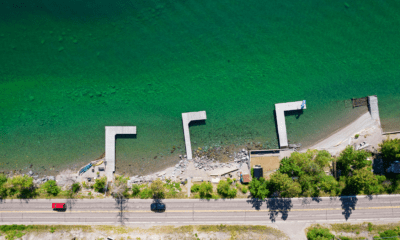Uncategorized
Salvaging history
Published
12 years agoon
Sunken timber symbolizes log drives and the rise of the Great Northern Railroad
By Emily Stifler Explorebigsky.com Managing Editor


the Flathead River, and the afternoon sun glistens off the
snow.
Five feet up the side of a massive western larch tree, two
lumberjacks stand on springboards jammed into notches in the
trunk, pulling a crosscut saw back and forth. The movement is
so smooth and rhythmic it looks effortless.
The year is 1924, and the men are contract workers for the
Great Northern Railroad. They work long days in the woods
and are indebted to the company, but they can’t imagine another
way of life—to leave the woods, the fresh mountain air
and the hard labor for a job in the office would be unthinkable.
Halfway through the tree they stop. With a flick of their
caulked boots, they shift the springboards sideways to better
their stances, and then pick up sawing where they left off.
The men have their sleeves rolled up, and sweat glistens on
their brows even though it’s winter in Montana. It’s nearly
the end of another long six-day workweek, and one of them is
thinking about the woman he once knew back in Minnesota.
The other is readying himself for the moonshine drunk he’ll
put on in town when he gets his quarterly wages.
When they’ve nearly sawed through the 200-year-old giant, it
begins to lean and creak, and they climb down to safety.
“Timber!” shouts one of the men as the tree leans further. It
pauses, defying gravity for a moment, then falls with a thunderous
crash and squeal, tearing through the underbrush and
bringing down several smaller trees with it.
The men limb the tree with their axes and buck the trunk into
12-foot sections. They stamp a Circle N brand into the ends,
marking ownership by Great Northern. Because the sawyers
are paid per log, this is also how they count their work.
From here, a team of horses will drag the logs across the snow
down to the Flathead River. There, along with thousands of
others, they will move 80 miles downstream in the annual
spring log drive.
Once the logs reach Flathead Lake, they will be barged by a
logging towboat toward Somers Bay at the north end of the
lake. There, they’ll float in the bays next to ponderosa pine
and Douglas-fir. The Doug-fir, the lightest and most buoyant
wood, will be pulled from the lake first and milled into railroad
ties. The larch, a heavier wood, will become waterlogged and
sink to the bottom of the lake.
The Northern Pacific Railroad reached Montana in the 1880s,
and the Great Northern followed soon after. The transcontinental
railway was completed in 1893, and the line continued
expanding throughout the Northwest. Since a mile of track
required 2,500 railroad ties, plus lumber for bridges, pilings,
telegraph poles and snow fences, the logging industry in Montana
grew alongside the railroads.
__________
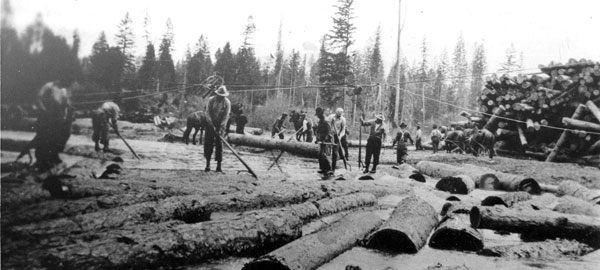

Logs cut in the region around Flathead Lake were shipped downstream in annual spring log drives and then barged to sawmills on the lakeshore. Photo courtesy of Northwest Management
Railroad, sent Minnesota lumberman John O’Brien to build a
sawmill on the north side
of Flathead Lake. Great
Northern completed an
11-mile spur line from
Kalispell to the mill site in
1900, and a year later the
town of Somers was born.
Named for George Somers,
a railroad executive, the
company town grew
quickly and was soon producing
millions of board
feet annually. Men came
from around the country to
work, and ethnic neighborhoods
called Swede Hill,
Dirty Dozen and Pickleville
popped up.
By 1937, the railroad company
employed 375 workers
and owned nearly everything there—the townsite,
the company store, the water and electric utilities, and
John O’Brien’s mansion on the hill above town.
In addition to railroad ties, lumber was produced
for flooring, molding and siding, and crates to
ship apples from the region’s orchards. Everything
was hauled away on the tracks.
From its company records it became evident that the
company paid the sawyers for more logs than were
processed at the mill. These missing logs—approximately
10 percent in all—had sunk.
After World War II the railroad moved its operation
to a tie plant nearby and closed the sawmill. Then in
1953, brothers George and Ron Devoe, through the newly
formed DeVoe Lumber Company, bought the old sawmill
and the rights to its property—including the sunken logs. The
brothers had grown up in Somers, and their father and other
family members had worked at the old mill.
The sunken logs, sometimes called “deadheads,” were valuable,
and the DeVoe Lumber Company recovered more than a
million board feet from Flathead Lake between 1955 and 1957.
Ron’s daughter Virginia DeVoe Gentry remembers watching
the divers.
“[They had] big helmets that
screwed down, and they’d
pump air down to them.
My dad always called them
pearl divers. My cousin and
I would sit out on the pilings
and watch the pearl divers go
down and bring up the logs.”
A fire destroyed the sawmill
in June 1957. The blaze
started at 5 a.m. and the
building was totally destroyed
by 7:30. Most of the
DeVoe family left Somers
soon after, Ron’s family to
Arizona, and George’s to
Idaho.
In 2004, George’s widow Donetta,
then in her 80s, convinced her friend
Alan Leener to help recover the logs.
In 2005, they established North Shore
Development LLC and hired Northwest
Management to oversee and
implement the project.
North Shore received a permit from the
Montana Department of Environmental
Quality to retrieve
the sunken timber
and began salvaging
it in spring of 2006.
__________
Without exposure
to oxygen, the wood
hadn’t rotted. And in
a stroke of luck, it was
beautifully stained
from sitting in the silt
for so many years—the
larch had turned chocolate brown,
with streaks of black, green and violet,
and the pine turned peach, black, gray,
charcoal and blue. Counting the rings
on one big twisted larch cut in 1924
dated it back to 1535.
But the project was stopped short when
the Montana Department of Natural
Resources claimed the logs belonged
to the state, as abandoned property.
Additionally, the state questioned the
environmental soundness of the salvage.
The dispute was settled in 2008.
All the logs branded with a circled N
stamp—those cut by the Great Northern
Railway—belonged the North
Shore. All others belonged to the state.
After the settlement, this agreement
was presented to the state land board,
including Governor Brian Schweitzer,
for approval of a land use license allowing
North Shore to salvage its own logs
as well as the state-owned
logs.
“These recovered
timbers present
another great opportunity
to showcase
Montana’s natural
resources and create
jobs in our state,”
said Schweitzer,
who has been a supporter of the project
ever since.
North Shore now has a 10-year license
from the state, during which time it
estimates it can produce 500,000 board
feet of lumber a year. The license is
renewable by North Shore for an additional
10 years.
Making sure the project is environmentally
sensitive remains a priority,
Leener says. Northwest has conducted
detailed water quality testing and
studies of the fishery. The choice to use
divers rather than a barge with a crane
to retrieve the logs was also an environmental
one, because the divers disturb
the lake bottom less.
Already, the areas where the logs have
been removed are seeing improved
habitat, with the added sunlight allowing
vegetation growth. And, Leener
points out that timber, particularly old
growth, isn’t necessarily a renewable
resource, so salvaging the logs instead
of cutting new trees is a sustainable
move.
Modern-day Somers is a sleepy artist community and summer tourist
destination on the lakeshore.
Many of the buildings on tiny
historic Main Street are painted
yellow, including Sliters Lumber
Company, which once housed the
company store. John O’Brien’s mansion
atop the hill is a monument to
days past.
Down the hill, small cottages now
sit where the mill workers’ hous –
ing once was. Looking east across
the lake, the Swan Mountains rise
above the deep green water.
__________
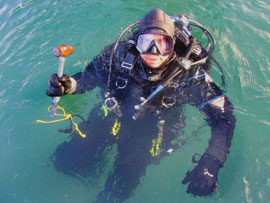

recession. He runs a karaoke show two nights a week, and his passion
is scuba diving. Bakker’s new job as a professional diver sends him below
20 feet of murky water in Flathead Lake in search of the sunken
timber.
Armed with scuba gear and a bag of ropes connected to foam buoys,
Bakker kicks and feels his way around in the lake’s murky water in
search of the logs. The currents in the north part of the lake, combined
with wind and runoff, stir up the water so much that Bakker
says sometimes he can’t see his hand in front of his face.
“I try to run by my compass to see which direction I’m going, but
sometimes you can’t see that, even if it’s lit,” he says. “You almost feel
like you become part of the bottom of the lake, like a bug.”
The murkiness really doesn’t matter though, because there are
logs everywhere. Once Bakker locates one, he feeds a rope under it,
hitching it about two feet from the end. Then he lets the little buoy
attached to the rope float to the surface, marking the log.
“I’m a true tree hugger—when I’m down there, to rest I’ll hug a log
and just sit there. It’s so peaceful. You’re in the darkness, and all you
can hear is yourself breathing.”
Most of the dives happen during spring, fall and winter—not when
recreational boaters are there in summer, and Bakker typically
works with a three-man team—two divers and a driver running the
modified pontoon workboat. The workboat winches the logs to the
surface and brings them to shore. They average 40 logs a day, he
says.
After being measured for board feet, the lumber is loaded onto trucks
and transported an hour down the road to Hunt’s Timbers, in St.
Ignatius. There, it’s milled into rough-cut lumber, tongue and groove
flooring and paneling.
__________
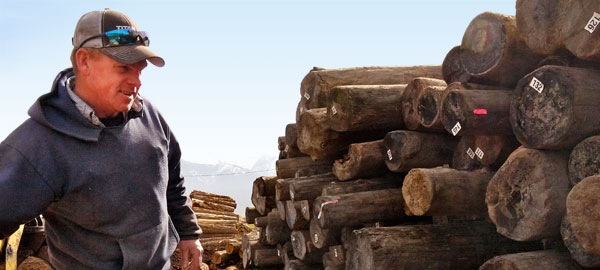

Hunt’s Timbers, a specialty mill in St. Ignatius, processes the logs salvaged from Flathead Lake. Here, Rusty Hunt surveys a stack. Photo by Emily Stifler
dramatic Mission Range. The mill has
been in the Hunt family for 33 years
and now employs between 14 and 18
people.
“We were born into it, in a sawdust
pile. This is all we know,” said Rusty
Hunt, red hair sticking out from his
baseball cap. Rusty and his brother
Robert run the lumberyard together.
With their father, the brothers have
built or customized nearly every machine
there. The planer, Rusty points
out, was built in the ‘20s.
“It’s about the age of some of them logs
we’re sawing. This is what they used in
that era.”
When it arrives, the Flathead Lake
lumber is sopping wet clear to the
middle and is four times the weight
of green wood. The guys at Hunt’s
mill it wet and then let it air-dry
for several weeks. Finally, it sits in
the lumber kiln for a week, until it
has only 12 percent of its moisture
content left.
“Probably one of the neatest things
about it is it was cut with a crosscut
saw, not a chainsaw,” Rusty says.
He turns a piece of 1 by 4-inch
tongue and groove flooring in his
hands, then runs his finger along a
streak of color.
“You never know what’s in it, just
like chocolates when you open the
box. When you saw the log you
find out what you’ve got.”
He likes seeing the finished products,
too, describing tables, mantles, trim,
bar tops, floors and entertainment
centers that customers have made with
the historic wood.
Historic wood salvage projects are taking
place in a small but growing number
of waterways around the country.
Probably the most famous of these is
the Great Lakes, where old growth
hardwoods like cherry, walnut and oak
are being pulled from the depths, some
left from logging drives and others
from shipwrecks. This wood is known
among stringed instrument builders for
its incredible sound.
The timber industry, alongside mining,
was the backbone of the country at the
turn of the century because it provided
materials for a growing nation. As the
largest freshwater lake west of the
Mississippi, Flathead Lake is a western
landmark. And while the Northwest’s
majestic old growth forests are now severely
diminished, this salvage project
connects all involved to a sense of the
region’s history and place.
Rusty Hunt knows that if you look
carefully, each log has a story. He pulls
out a piece he imagines will become a
fireplace mantel.
“This was used as a boom log that the
logger stacked in to build a cribbing
pile,” he says, pointing to the “saddle
notches” cut into it with an axe. Its butt
end is stamped with a Circle N and also
the number 19, meaning it was cut in
1919.
“Nobody knows how much is down
there,” he says.
Dan Roberts Stringworks
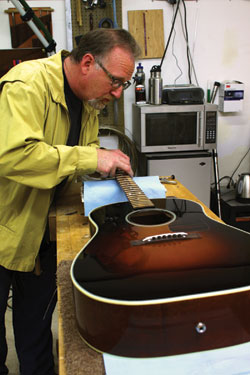

in Belgrade is a small slab of Western larch milled from
Flathead Lake salvaged timber. It’s a rich, dark color, and
is rough to the touch.
Guitars are typically made from spruce or mahogany,
and in the tradition-driven stringed instrument market,
“if you want to use something a little unusual, you better
be a real well known builder or have some proof,”
Roberts says.
With more than 25 years of experience building guitars,
including a tenure with Santa Cruz, Roberts is one of
the most respected luthiers in the country. Careful and
precise in his work, he takes every piece of wood to a
different thickness, based on its stiffness, density and
tap tone. He compares himself to a chef working without
a recipe, guided by intuition.
Roberts built a larch guitar a few years ago, and said it’s
heavier, but had a warm, mellow sound. He’s fascinated
by the idea of building a guitar from the salvaged larch,
and said luthiers have used wood salvaged from the
Great Lakes with great results.
Old growth lumber from the salvage operations tends to
have a tight, even grain. As it ages, even while underwater,
wood becomes lighter and stiffer, and the lake water
forces the pitch out, crystallizing the resins.
“Having a story behind the wood makes it more personal,”
he says. He plans to inlay mother of pearl in the
shape of barbed wire on the front of the larch guitar,
naming it “Don’t Fence Me In” after cowboy poet Cole
Porter’s famous song.
“We’ll see. It’s experimental,” he says.
Fish Camp
Haas Builders of Big Sky is using
Flathead Lake historic timber for all
of the interior woodwork in a house
it’s building in the Spanish Peaks this
summer. Called Fish Camp, the custom
home is set near the south fork of the
Gallatin River’s west fork, and will be
constructed from 90-95 percent North
American products, said company
owner John Haas.
Haas plans to use Flathead lumber for
all interior trim, doors, cabinetry, wood
ceilings and wainscoating.
“This is the epitome—to have a lumber
company, a material supplier from the
state of Montana, and the history of it
is pretty cool,” he said. “I showed it to
my interior designer, Michelle Varda,
and she fell in love with it. It’s gorgeous
wood.”
This story was originally published in the Summer 2012 edition of Mountain Outlaw magazine. Read more here. For more information on Montana businesses using the wood, read about luther Dan Roberts and builder John Haas, below.
Megan Paulson is the Co-Founder and Chief Operating Officer of Outlaw Partners.


Upcoming Events
april, 2024
Event Type :
All
All
Arts
Education
Music
Other
Sports
Event Details
We all are familiar with using a limited palette, but do you use one? Do you know how to use a
more
Event Details
We all are familiar with using a limited palette, but do you use one? Do you know how to use a limited palette to create different color combinations? Are you tired of carrying around 15-20 different tubes when you paint plein air? Have you ever wanted to create a certain “mood” in a painting but failed? Do you create a lot of mud? Do you struggle to achieve color harmony? All these problems are addressed in John’s workbook in clear and concise language!
Based on the bestselling “Limited Palatte, Unlimited Color” workbook written by John Pototschnik, the workshop is run by Maggie Shane and Annie McCoy, accomplished landscape (acrylic) and plein air (oil) artists,exhibitors at the Big Sky Artists’ Studio & Gallery and members of the Big Sky Artists Collective.
Each student will receive a copy of “Limited Palette, Unlimited Color” to keep and take home to continue your limited palette journey. We will show you how to use the color wheel and mix your own clean mixtures to successfully create a mood for your paintings.
Each day, we will create a different limited palette color chart and paint a version of a simple landscape using John’s directives. You will then be able to go home and paint more schemes using the book for guidance.
Workshop is open to painters (oil or acrylic) of any level although students must have some basic knowledge of the medium he or she uses. Students will be provided the book ($92 value), color wheel, value scale and canvas papers to complete the daily exercises.
Sundays, April 14, 21 and 28, 2024
Noon until 6PM.
$170.
Time
14 (Sunday) 12:00 pm - 28 (Sunday) 6:00 pm

